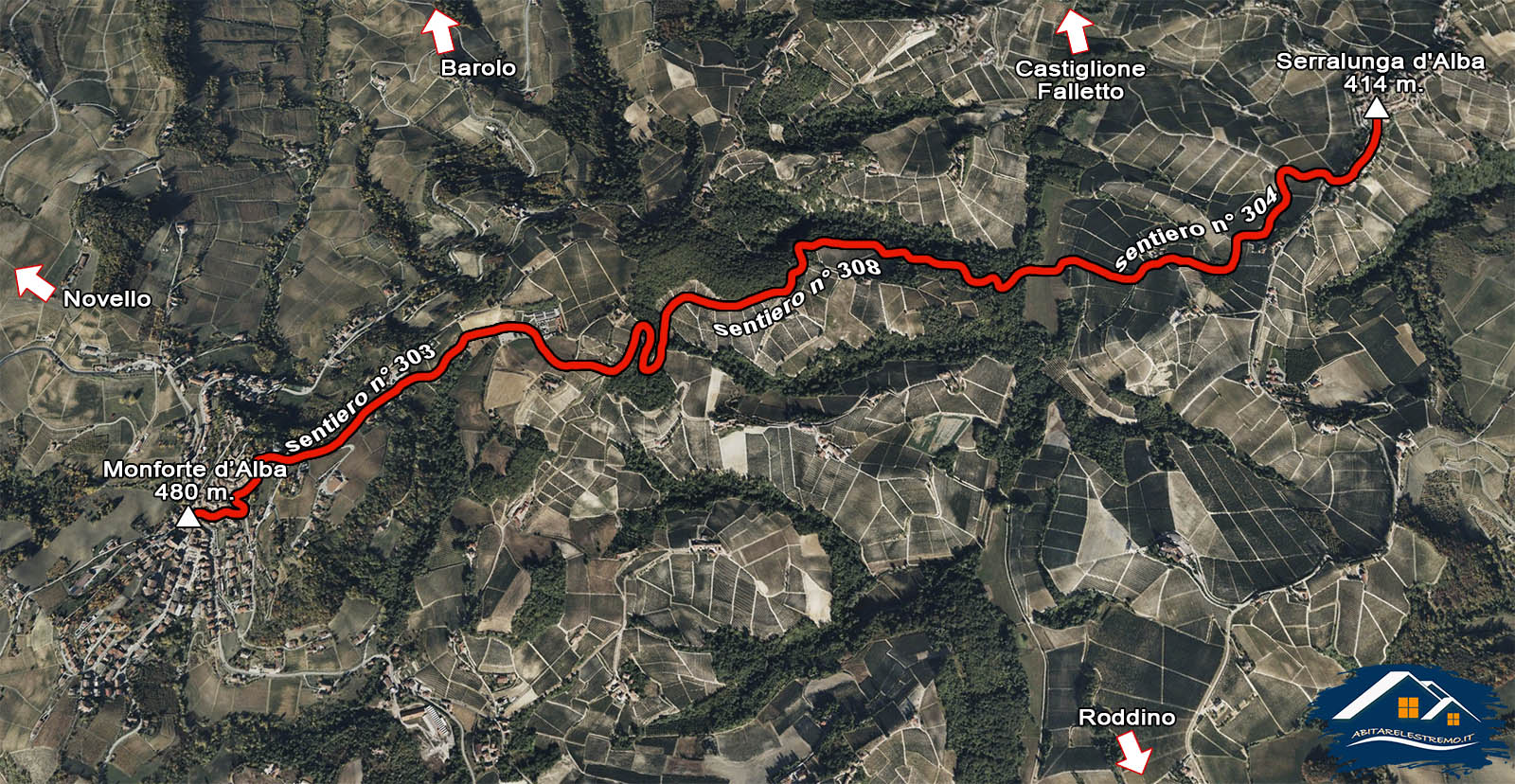“The Paths of Barolo”:
Monforte d’Alba – Serralunga d’Alba – Monforte d’Alba
(Italy – Monforte d’Alba)
pleasant and relaxing trekking route connecting two prestigious medieval villages. Enchanting views of the hills with
passages through the vineyards and at your side you will have the entire chain of the Alps with Monviso
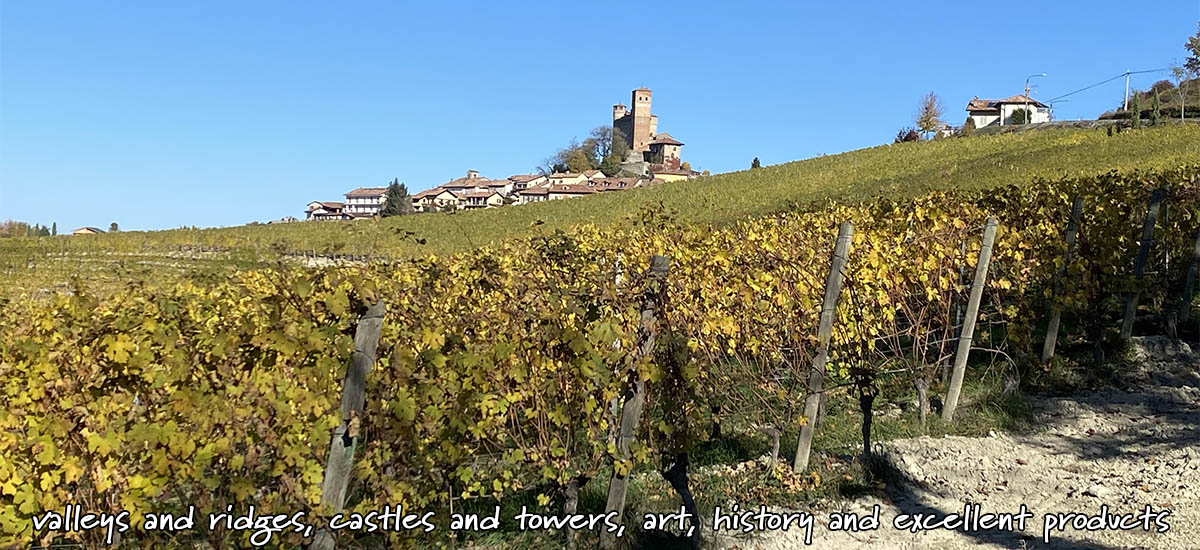
Starting location: Monforte d’Alba 480 m. (CN)
Intermediate locality: Serralunga d’Alba 414 m. (CN)
Finish location: Monforte d’Alba 480 m. (CN)
Time required: 1h 45’ outward route and 1h 45′ return route
timing that does not take into account the visit and tour in the beautiful town of Serralunga d’Alba
Height difference: 107 m.
Signposts: n° 303 – 308 – 304
Difficulty level: E [level scale]
Period: all year round
Equipment required: classic trekking equipment
Waste: here’s what you need to know before abandoning it
The Langhe with its hills and dense network of itineraries have always led us to discover not only prestigious villages,
but also smaller towns, corners of art, enchanting villages, often made up of just a few houses, incredible
and extraordinary viewpoints, combined with solitary chapels centuries old.
We returned to one of the places we love to explore and enjoy a new trekking route.
Today’s ingredients for the day:
– 2 medieval villages of rare beauty
– a paved farm road
– a dirt farm road
– a forest
– the crossing of prestigious vineyards
– some “ciabot”
– a path that runs along the “combed” and manicured rows of vines
– a relaxing stop on a panoramic terrace with perfect temperature and warm sun
– fabulous colors around us
We have everything to start telling you about this trekking excursion, faced on a hot (too hot),
late November day, along one of the “Paths of Barolo”, which gave us some really pleasant moments in
an extraordinary environment, as the Langhe have always accustomed us to.
Welcome or welcome back to the pages of our website.
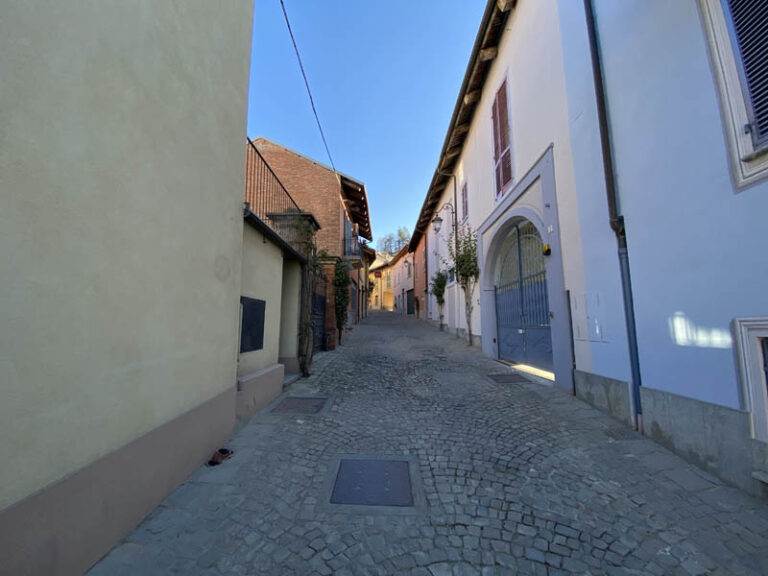
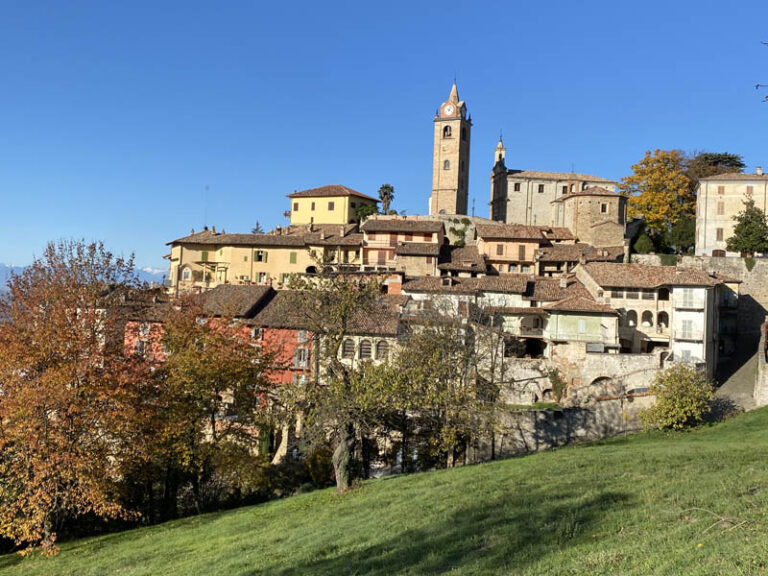
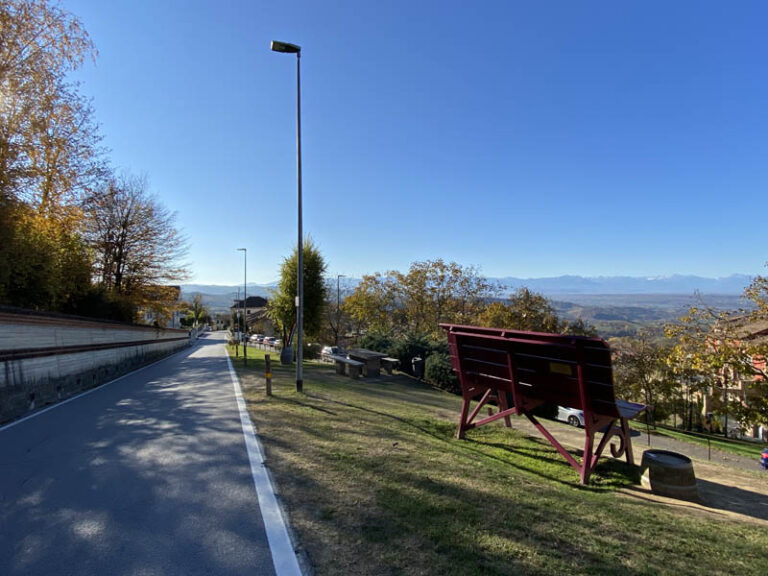
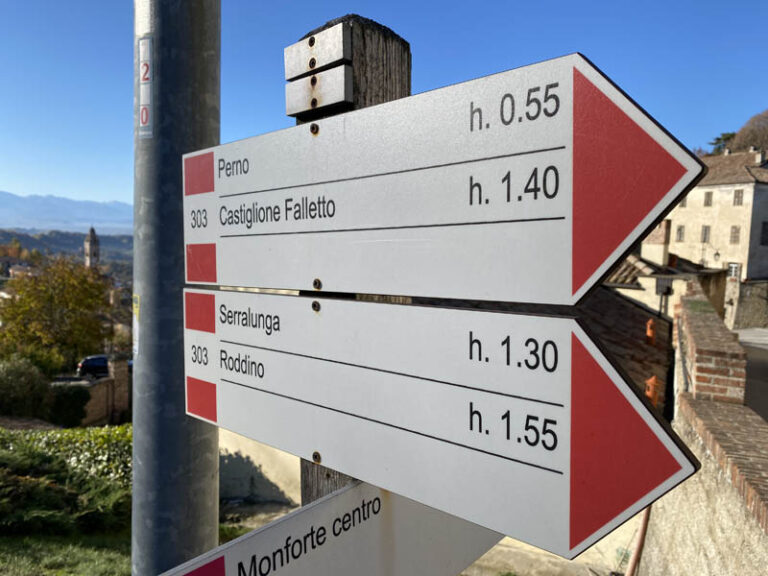
The starting point for today’s excursion is the village of Monforte d’Alba, which is part of the “most beautiful villages
in Italy” and the Union of the 11 Communes of Langhe and Barolo.
Monforte d’Alba, which we visited and described within our website, is a romantic, pleasant town,
largely perched on a hill and surrounded by hills.
A medieval village that deserves to be visited and appreciated.
We reach Piazza Umberto I where we find the sign for Trail No. 303 that leads toward Serralunga d’Alba
our final destination, which is about 1h 45 minutes from here.
We enter the village going up first via Vittorio Emanuele II, then via Circonvallazione and then
via Generale Beccaria, where we find one of the two “giant benches” of the village, from which it is possible
to admire a very open view of the village and of the whole chain of the Alps, now clearly visible on the horizon
together with the Tanaro Valley.
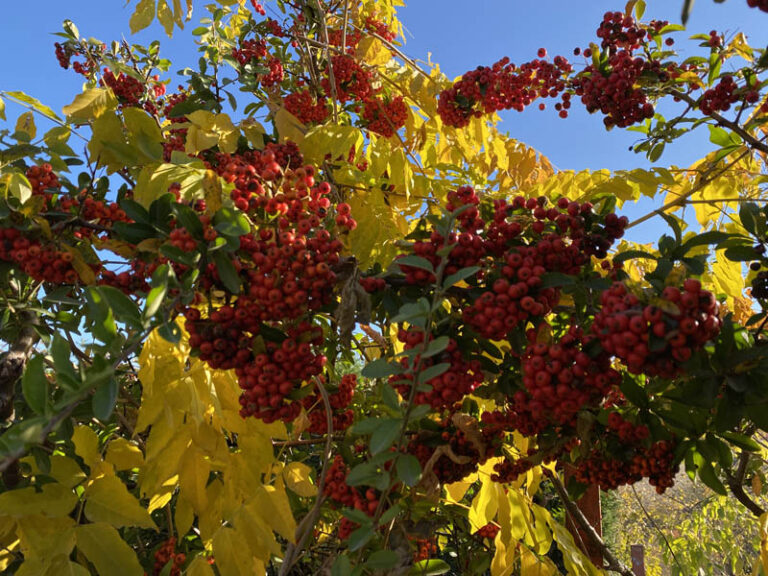
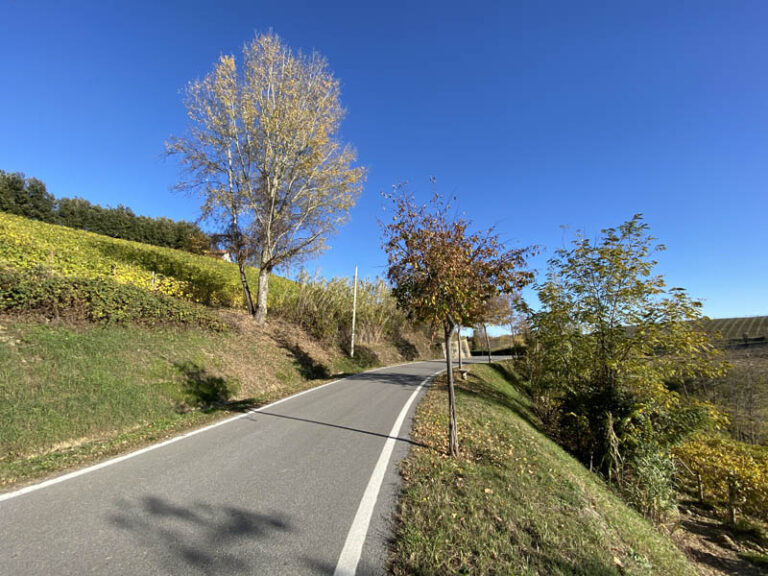
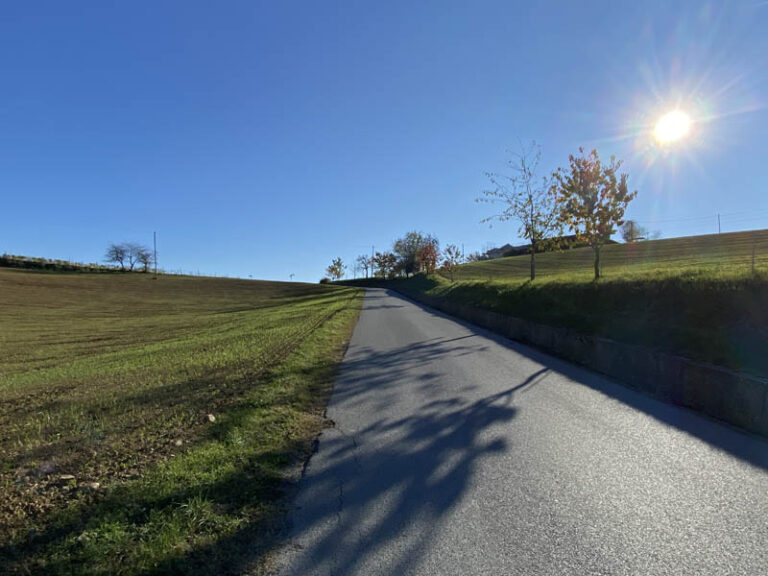
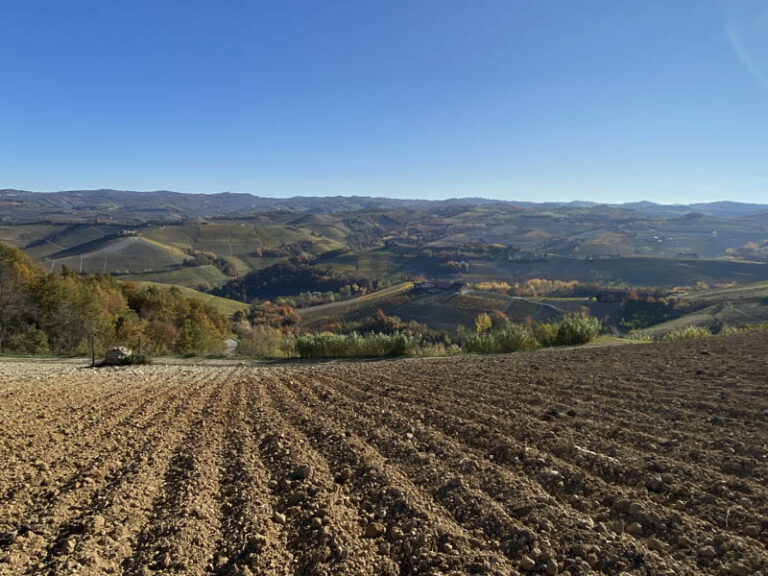
We continue following the paved road that as we advance turns into a narrow road, going to
lap the first vineyards and passing by large bushes of red berries with the yellow leaves of autumn
in wonderful colors.
Later this small road, after passing the area of the village cemetery and after passing and omitting
the junction for the path that leads toward Castiglione Falletto, will open our view of cultivated fields and an infinity
of hills that disperse to the horizon where we stop to admire this beauty.
Today the day is particularly clear, free of haze.
We are literally enraptured by these hills that gently rise and fall overlapping each other, among vineyards and
paths that tangle and where “getting lost” and “wandering” would allow us to savor the true treasure
of these lands.
The profile of the mountains on the horizon, and the various farmsteads that cross the Langhe without borders
or demarcation lines, convince us more and more of the value of these fantastic places in every season of the year.
Elusive landscapes capable of marveling with winding paths that follow the sinuous and irregular course
of the hills.
If I did not have the ambition and desire to continue today’s trek to reach the village of Serralunga d’Alba,
I would pull up a chair to spend several hours of the day here, on this field, simply gazing at the horizon.
A horizon formed by villages and castles, where viticulture literally dominates the landscape and still constitutes
its most important heritage, recognized in 2014 by UNESCO as a World Heritage Site,
also for the link between man and the environment.

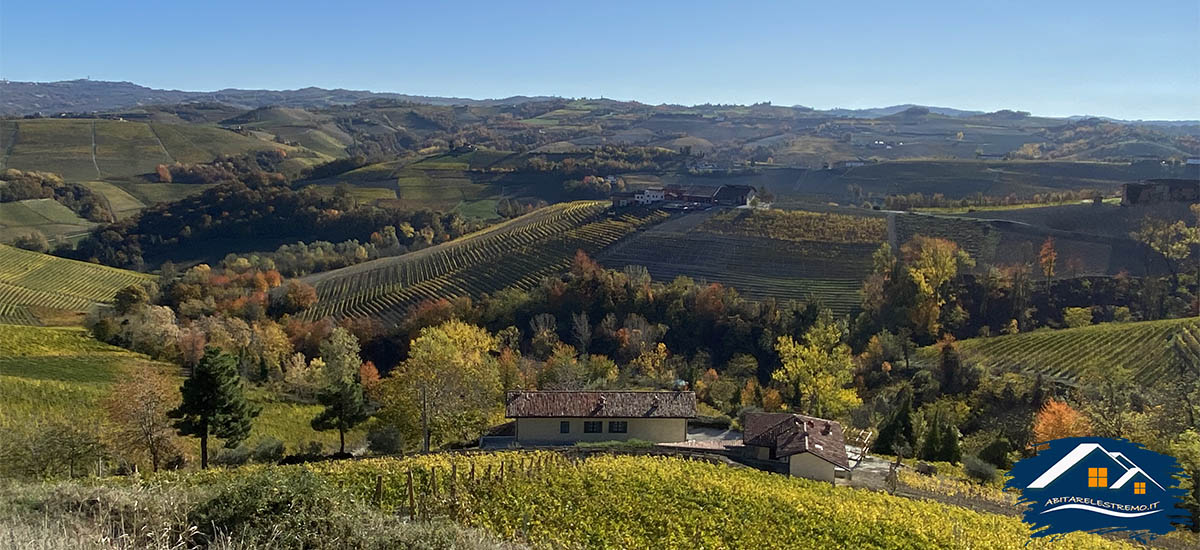
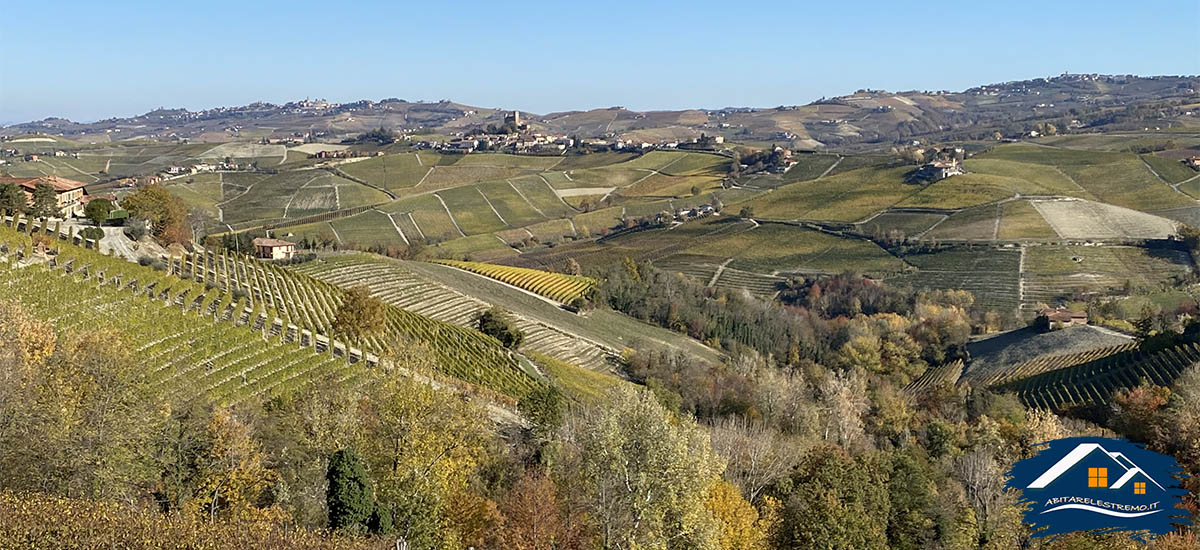
After a pause in front of so much spectacle, we set off again faithfully following the small asphalt road,
which in the meantime has turned into trail No. 308 marked by the classic red and white signs that we usually
find along the trails confirming the correctness of the route.
The small road descends gently with a few bends and enters inside a forest with a thousand leaves colored
by late autumn.
The sun filters through the branches forming a play of light and shadows and when the trees thin out,
a wonderful “window” opens on other vineyards, almost combed and lined up next to each other with a manic order.
The autumn sun with its still long shadows, the trees colored from red to yellow, green to orange,
make this corner we are walking through a little picture similar to a painter’s canvas.
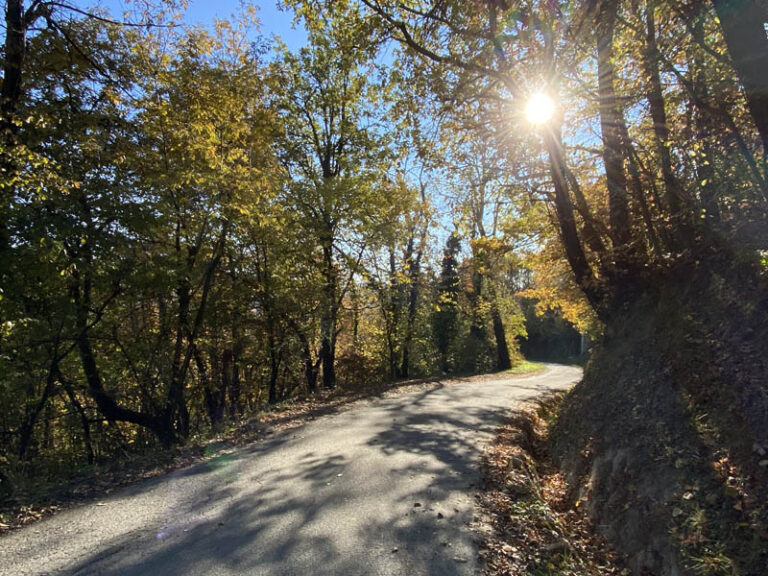
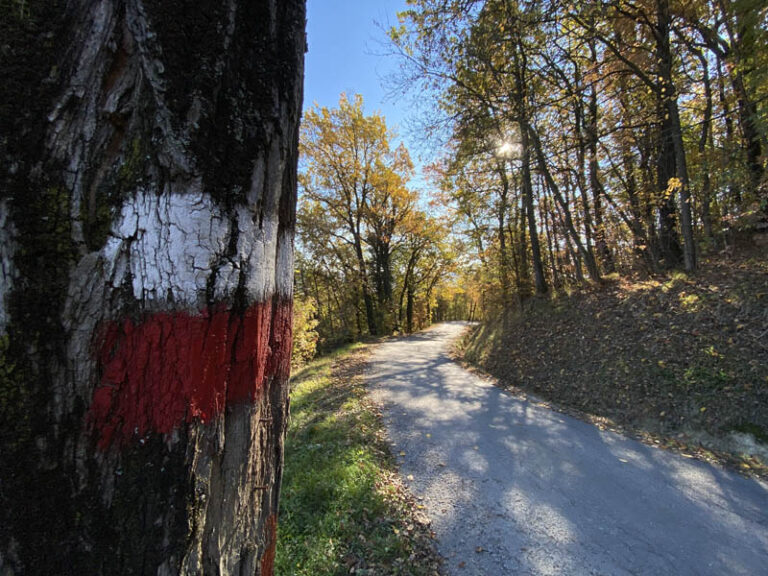
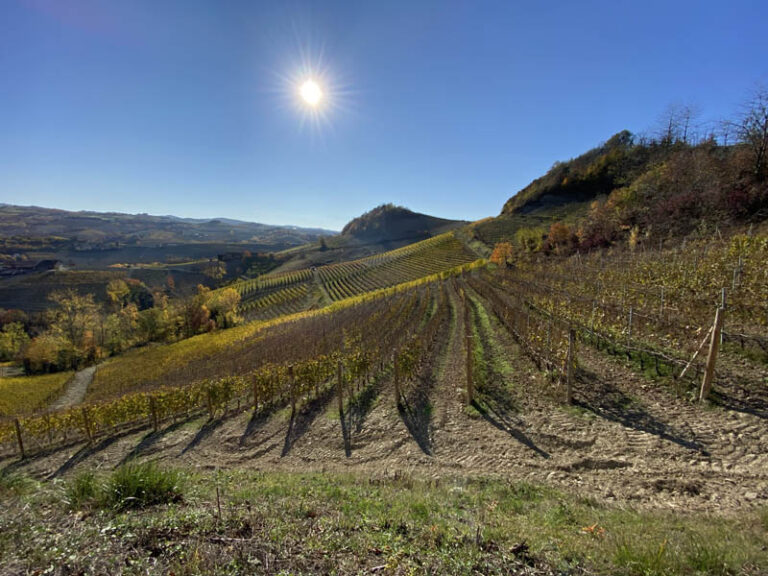
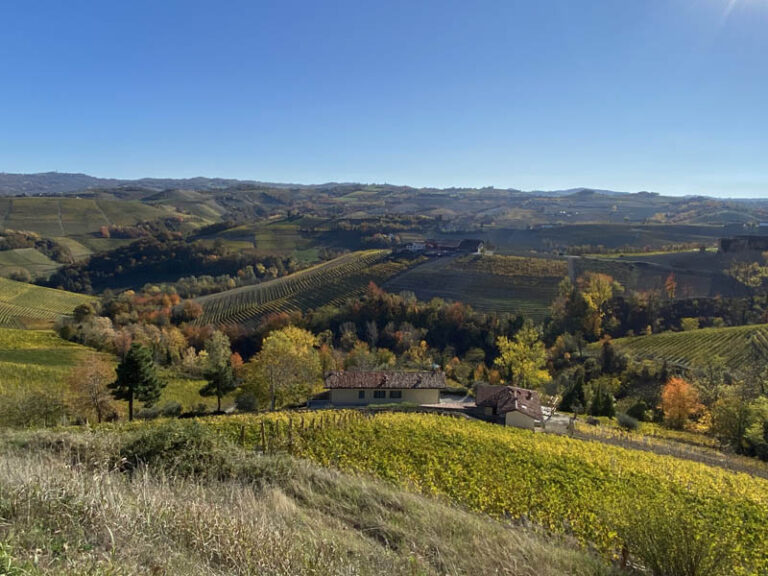
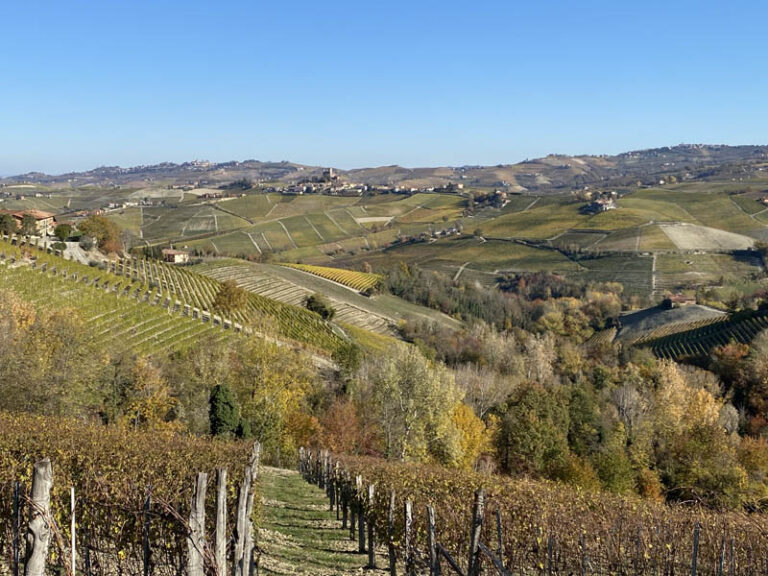
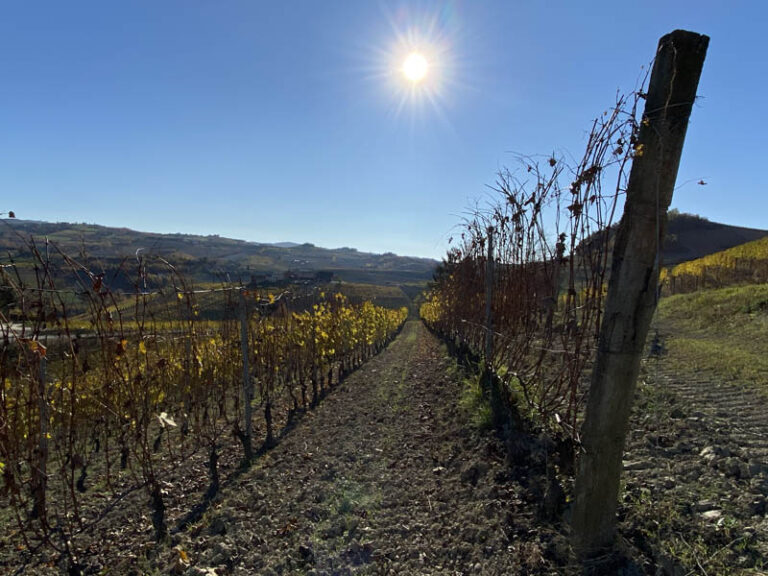
Coming out of the woods, as we walk past rows of vines with now yellowing leaves, we catch a glimpse
of Serralunga d’Alba with its majestic castle on the horizon on a hillock.
The small asphalt road ends here and turns into a dirt track with the trail number changing again and
becoming 304.
The signs are always present along the entire section and allow you to orient yourself with ease.
The trail number varies from 303 in the initial part, then changes to 308 in the middle part and then to 304
in the last section.
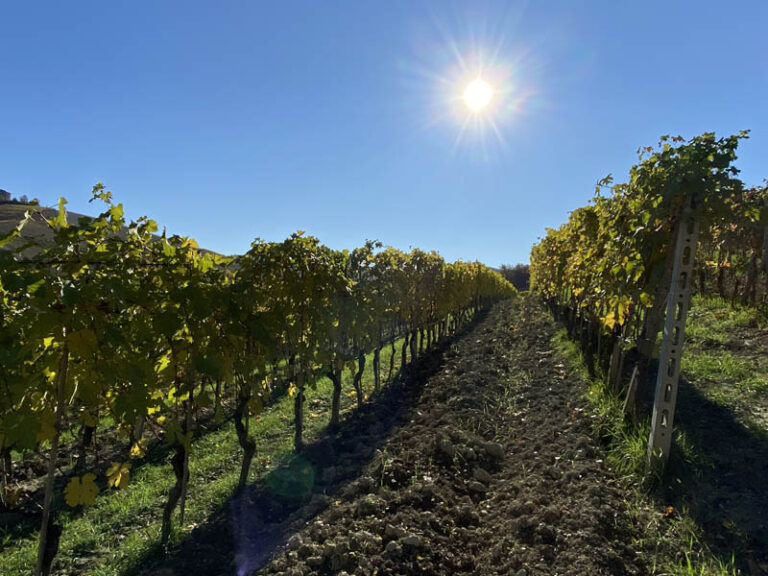
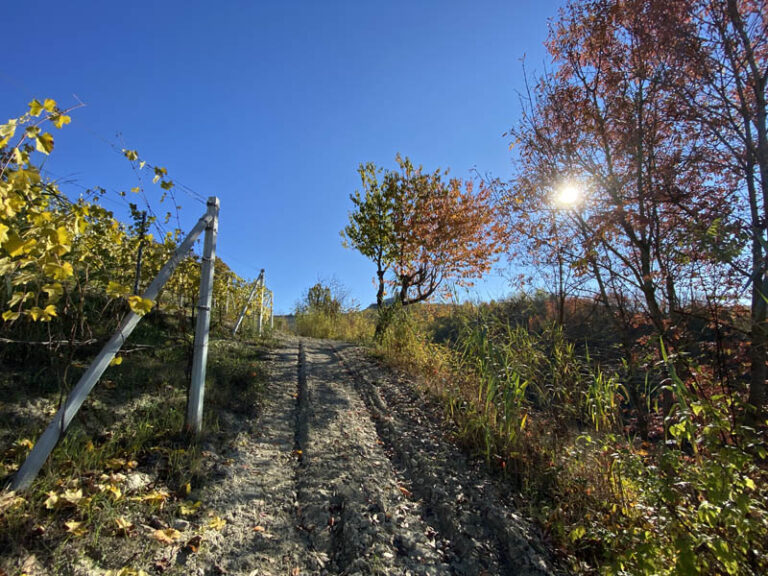
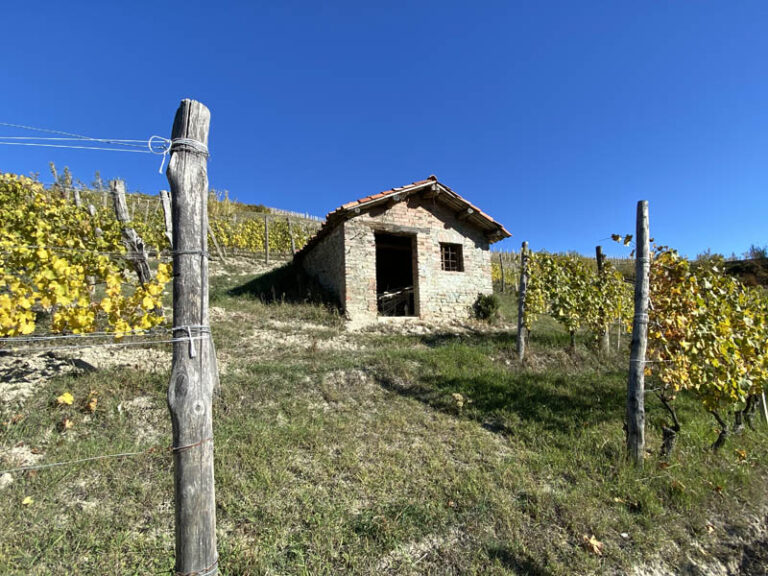
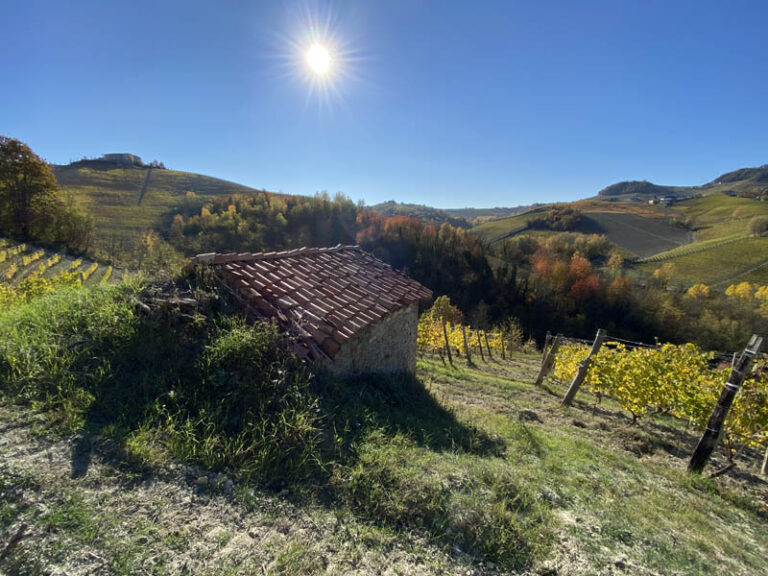
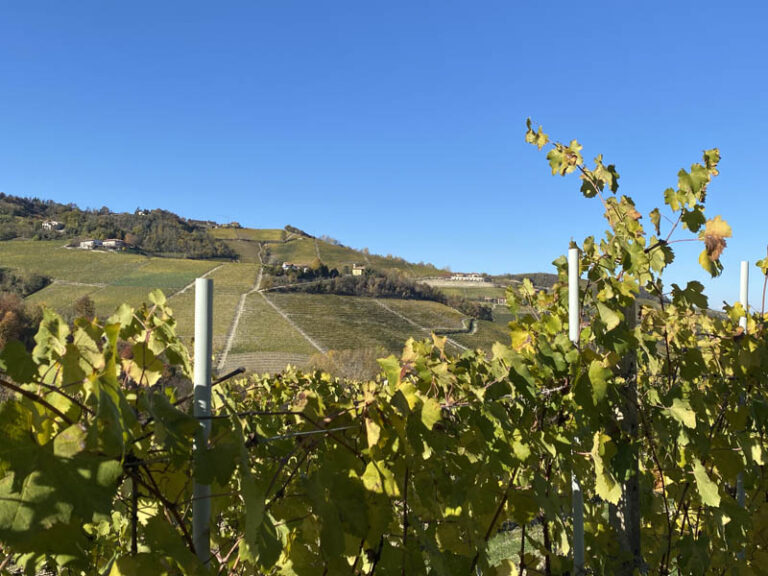
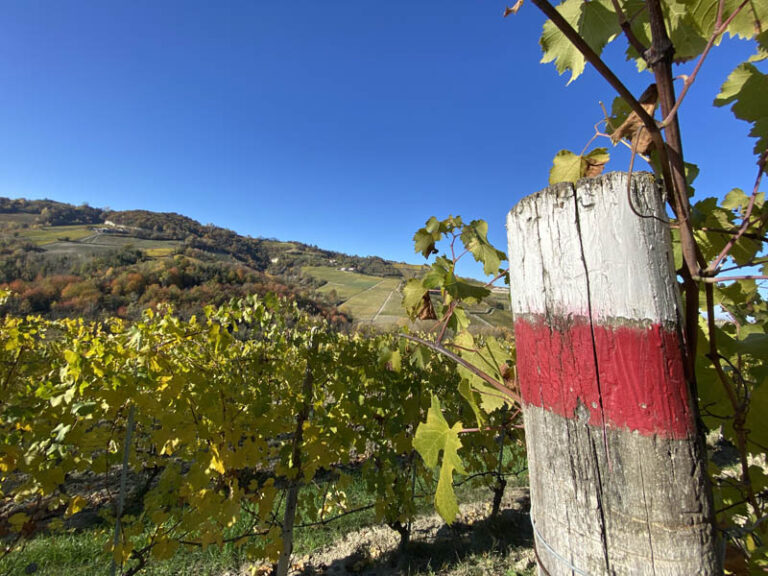
We ascend a steep hill that goes into the vineyards, bringing us near a “ciabot” that we have appreciated
on several other excursions that have taken place in these areas.
With the Piedmontese term “ciabot,” we identify old cottages that we find among the fields and that suddenly
pop up between the rows.
These are small and characteristic rather ancient constructions, now used as shelters for tools used
in agriculture and “scattered” a bit everywhere in these territories.
But in years past, the “ciabot” had a quite different function.
Farmers who worked the fields, living far away and unable to return home in the evening, used these small
constructions as shelter and a place of refreshment after the day.
The walk we are taking between the rows of path number 304 next to the wooden poles that support the vines,
on mixed soil and grassland, is particularly pleasant.
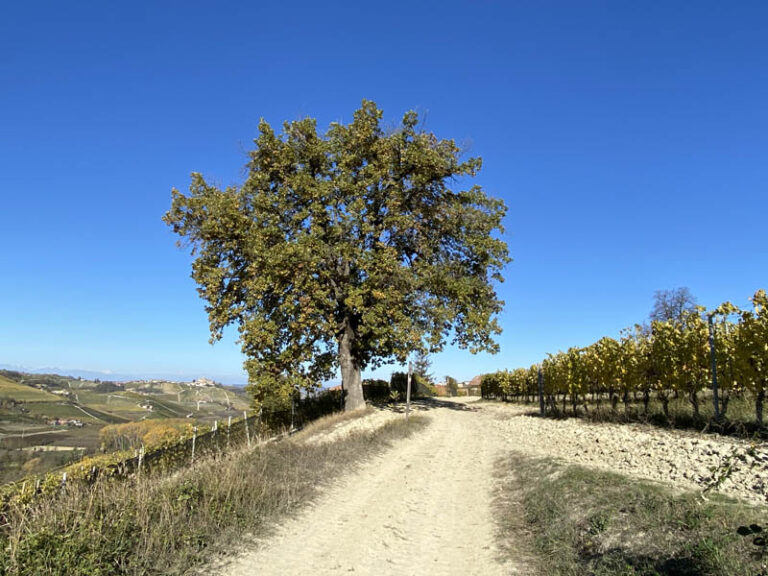
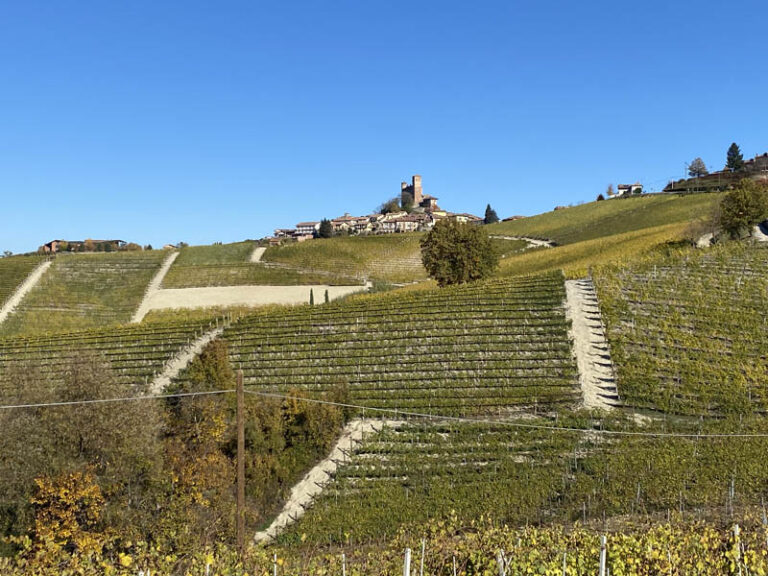
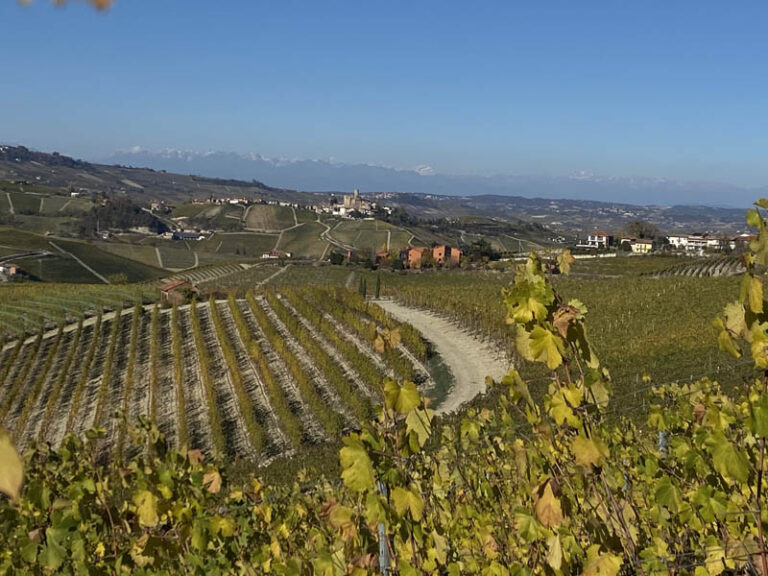
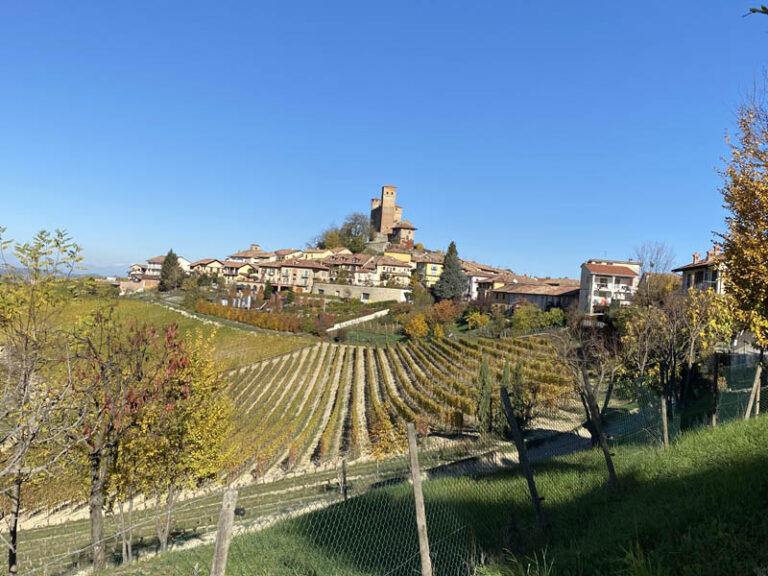
Everywhere we look, we find ourselves literally surrounded by hills, where perched villages sprout up here
and there, old churches isolated in the middle of nowhere, dozens and dozens of light-brown rammed-earth roads,
rising and curving in a thousand directions.
Impossible to even think of walking them all, even knowing that each one carries with it an equally fascinating,
scenic route with other views and rich in history.
Along the way we find the Peirass (large stone), which is a prehistoric boulder.
While at first glance (we admit our ignorance about it), it seemed to us to be just another boulder, in fact it is not.
The round holes inside this stone, were carved by man with rudimentary chisels, and their function is
shrouded in mystery.
It is claimed that they were used to melt metals, or to keep lightning away, or to collect water energized by the stone.
The ancestors of the Collaretto hamlet handed down the legend that a witch intent on spinning wool by
candlelight appeared on this stone after midnight.
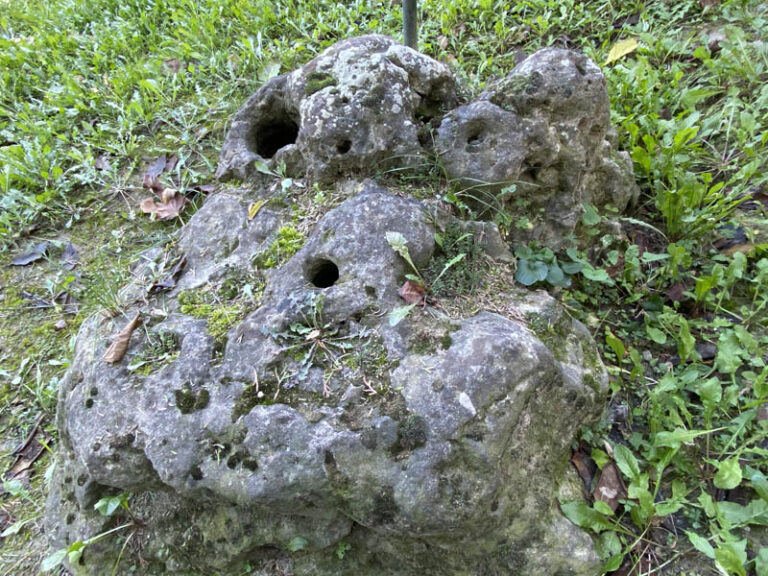
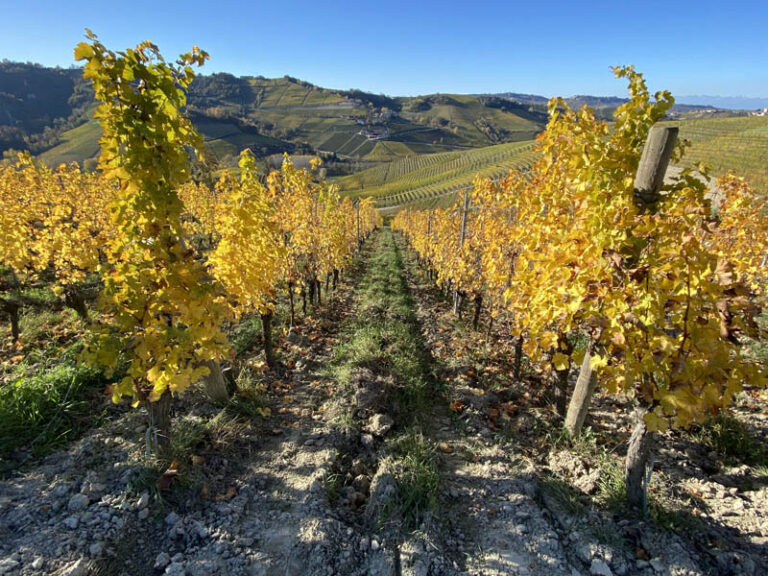
We left the path to pass onto a concrete road, which we walked along for about ten minutes, then climbed
back up to take a short stretch of Provincial Road SP125, which in a few minutes took us to Via XX Settembre
in Serralunga d’Alba.
Before going deeper into the village, we stopped at Piazzetta Belvedere where the name already describes
what awaits us.
Here, too, there are breathtaking views not only of the hills, and of the nearby village of Castiglione Falletto,
but also of the entire chain of the Alps from which Monviso stands out, clearly visible today.
A mix of countryside and mountains, of agriculture and villages.
In Piazzetta Belvedere, you will find comfortable wooden benches with footrests, where you can relax while
admiring the view.
In our case, despite being on a day in late November, accomplice a very high temperature compared to the
period, we took advantage of a break in the sun, almost in short sleeves (!!), relaxing for a moment in this
corner of paradise.
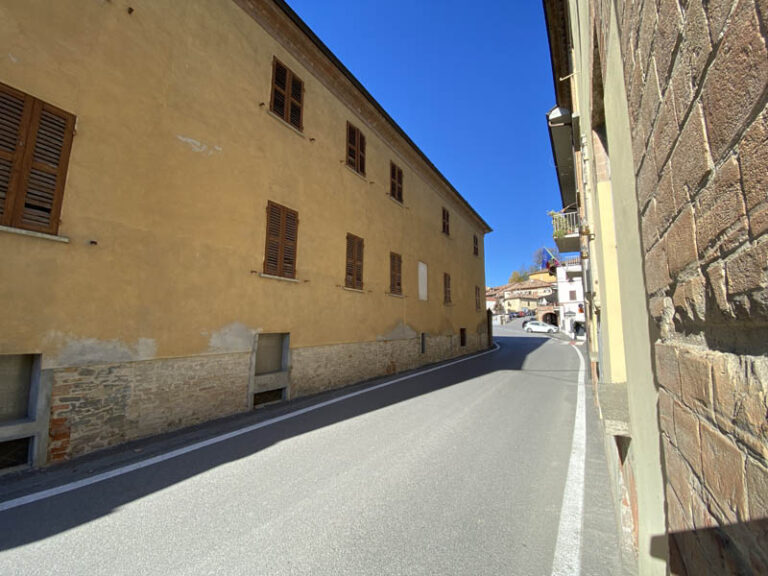
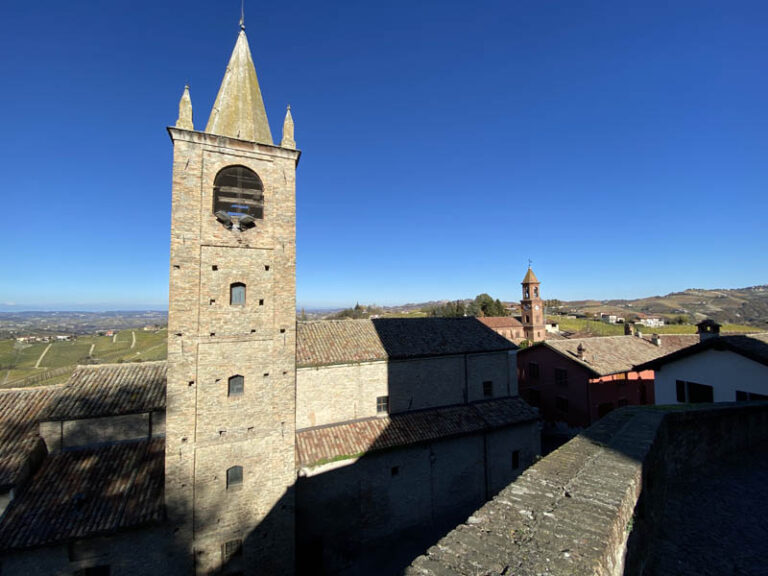
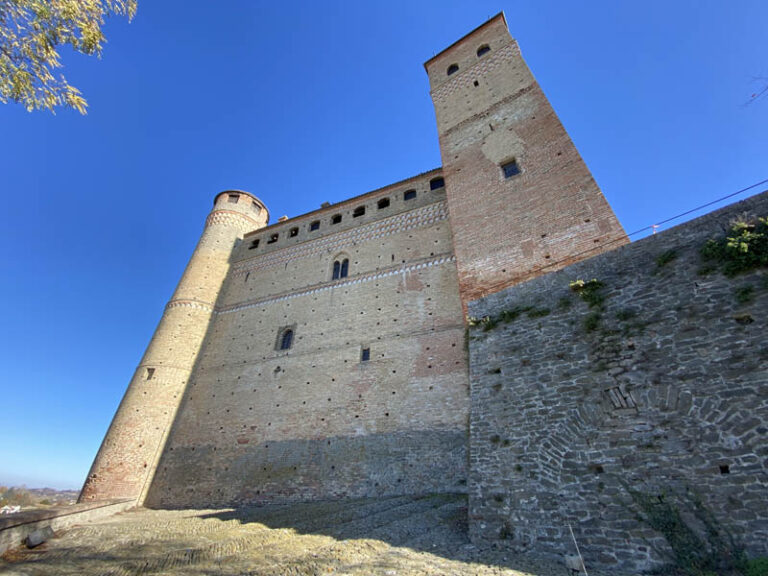
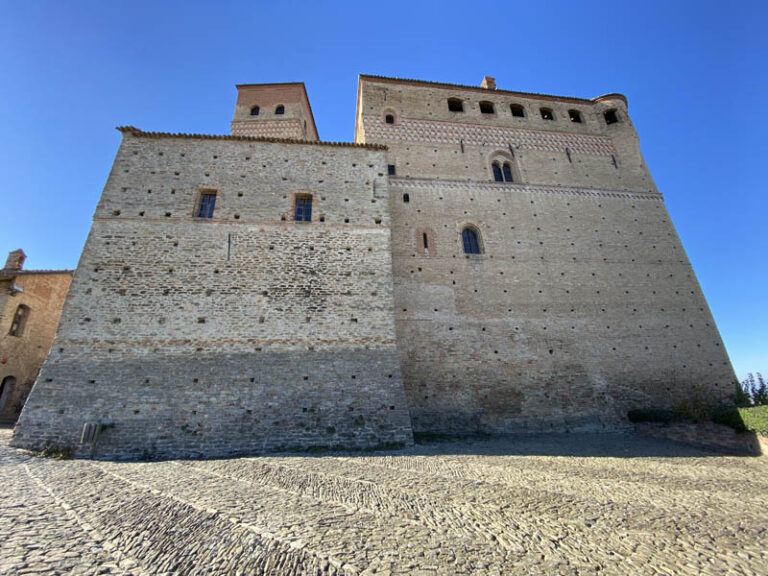
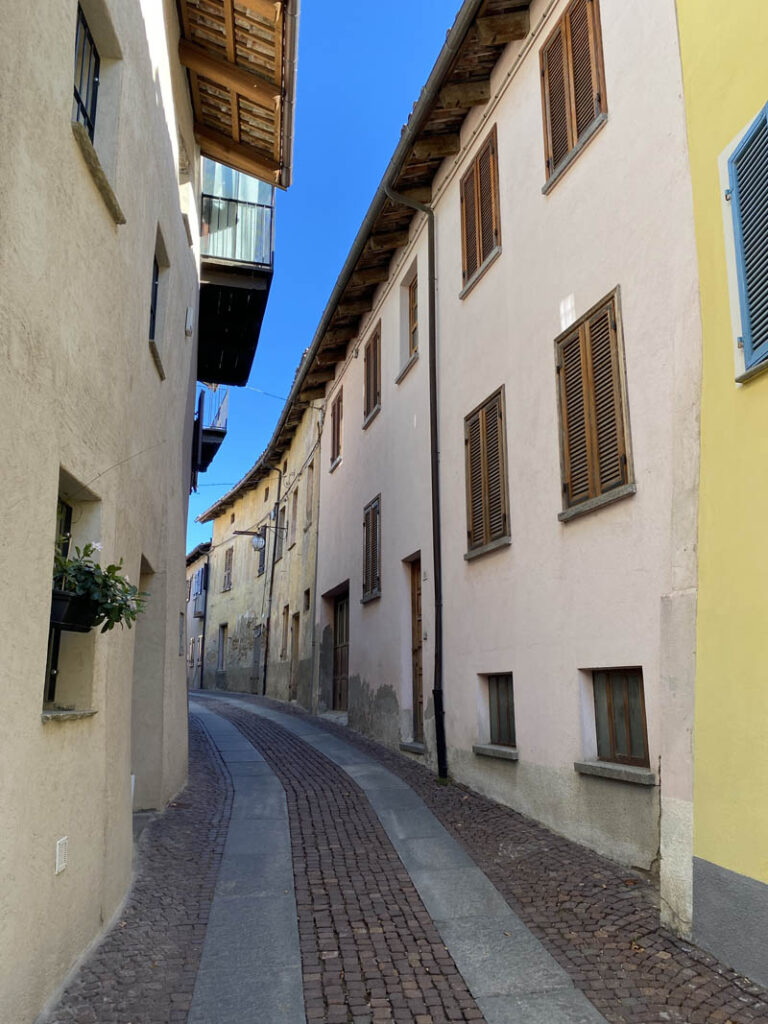
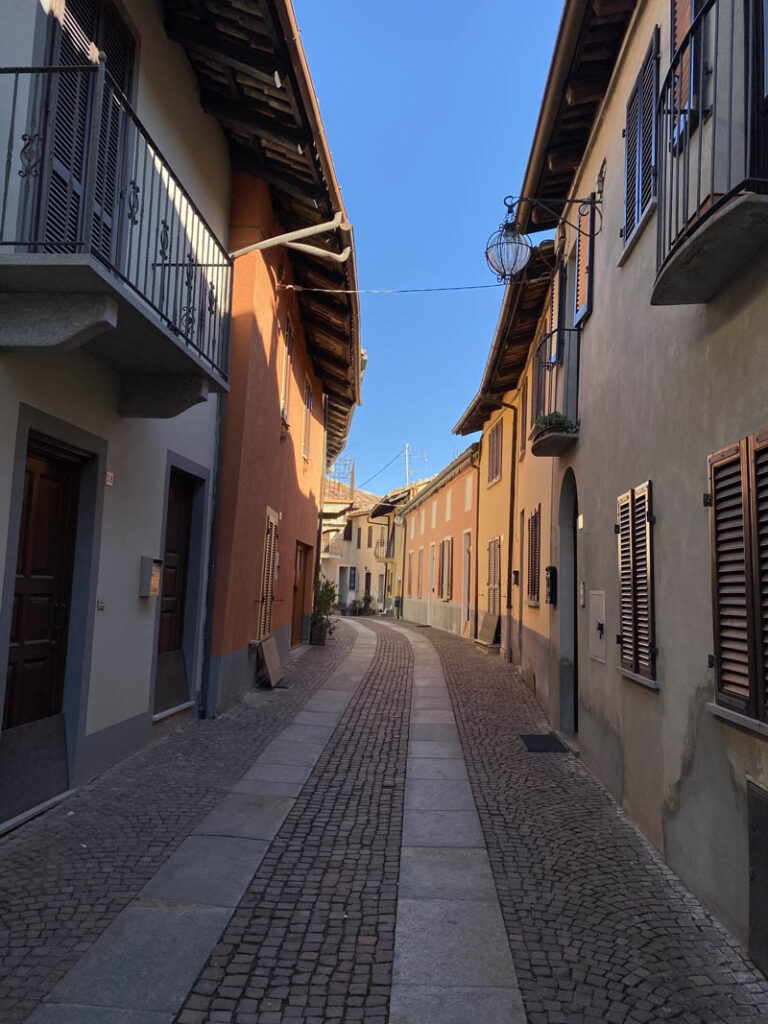
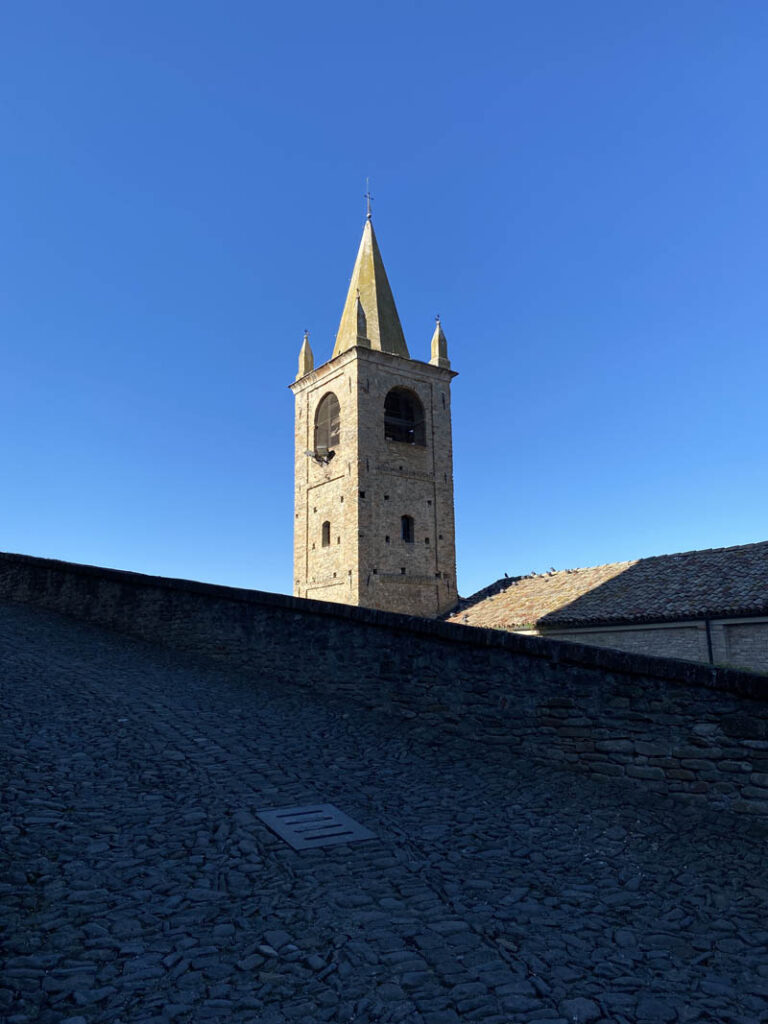
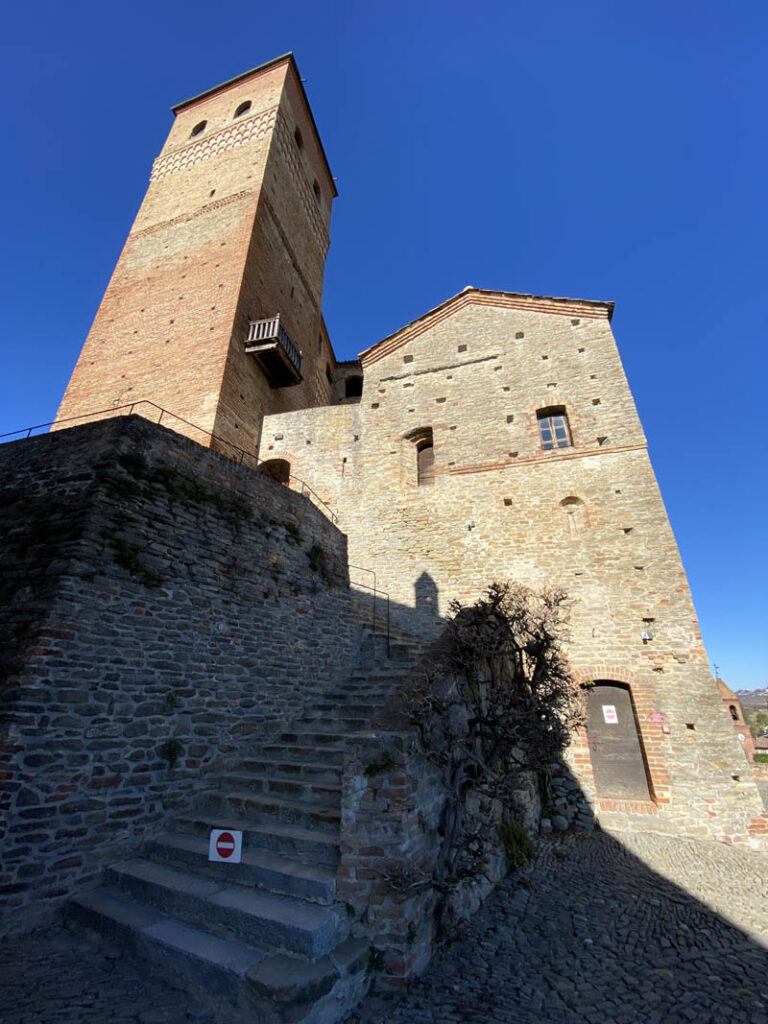
Serralunga d’Alba is a small medieval village of about 600 inhabitants, perched on a hillock from which
its imposing castle rises.
We are talking about a slender and majestic structure, built in the year 1300 and dominating the entire village.
Unlike other castles, that of Serralunga d’Alba has never had a great military role, and its function over the
centuries has been more to control the various production activities.
The narrow streets of Serralunga d’Alba are almost all cobblestone, arranged in a radial pattern, squeezed
between the houses and leading toward the center of the village represented by this imposing structure.
This is a very ancient place with almost a thousand years of life and history.
Its church, bell tower, stone walls, narrow streets, buildings, and stairs create a special atmosphere to this
village, another pearl of the Langhe that deserves to be included among the things to see.
After a visit to the village and another stop at the Piazzetta Belvedere to admire the view, we resumed the
return route, which was the same as the one taken on the outward journey.
The shorter days at this time of year and the sun that tends to set quickly, have changed the colors of the return
route compared to the morning, making them even brighter, with the shadows lengthened.
This route is also part of the “Paths of Barolo.”
It is difficult if not impossible to recommend one route over another.
They are all different, all particularly beautiful, and unite the various villages scattered throughout this paradise.
As you know if you frequent our site, we particularly love trekking and going out to discover new trails.
We always follow the trails relying on cairns, signs, and various markers, never losing the indicated trail, which
especially in the mountains is an indispensable safety.
We use the same “style” here in the Langhe in order to be able to tell, describe and illustrate the various hikes
as accurately as possible.
But in one of the next treks, quite exclusively, we will walk without a precise destination, starting from a village
and then getting lost in the hills, among the mule tracks, hazel groves and vineyards of this wonderful and
fascinating land.
For once we will be guided by instinct and the landscape, going to discover nooks and tiny villages unknown to us
today to once again fill our eyes and hearts.
Report, photographs and video footage by: Michele Giordano and Andreina Baj
Official translator of abitarelestremo: Andreina Baj
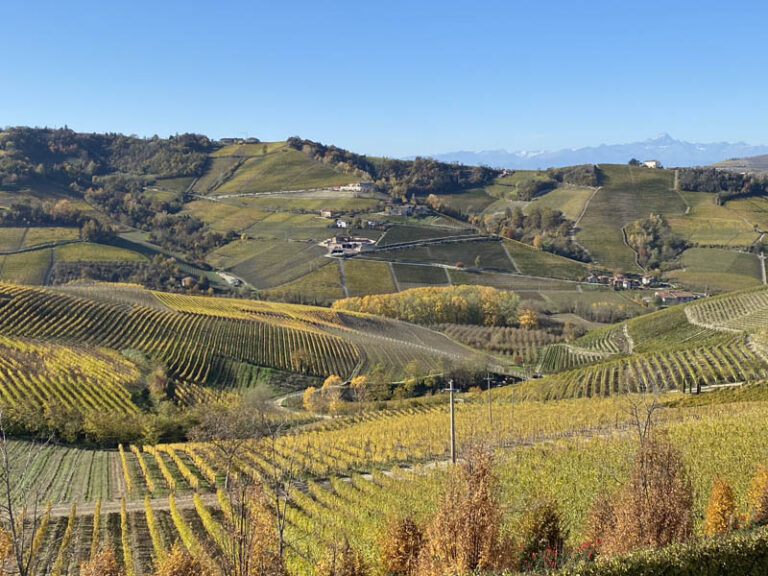
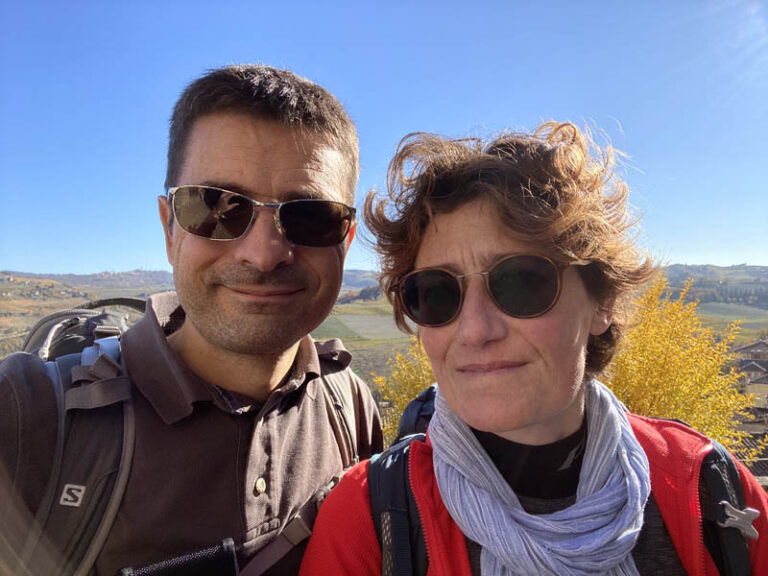
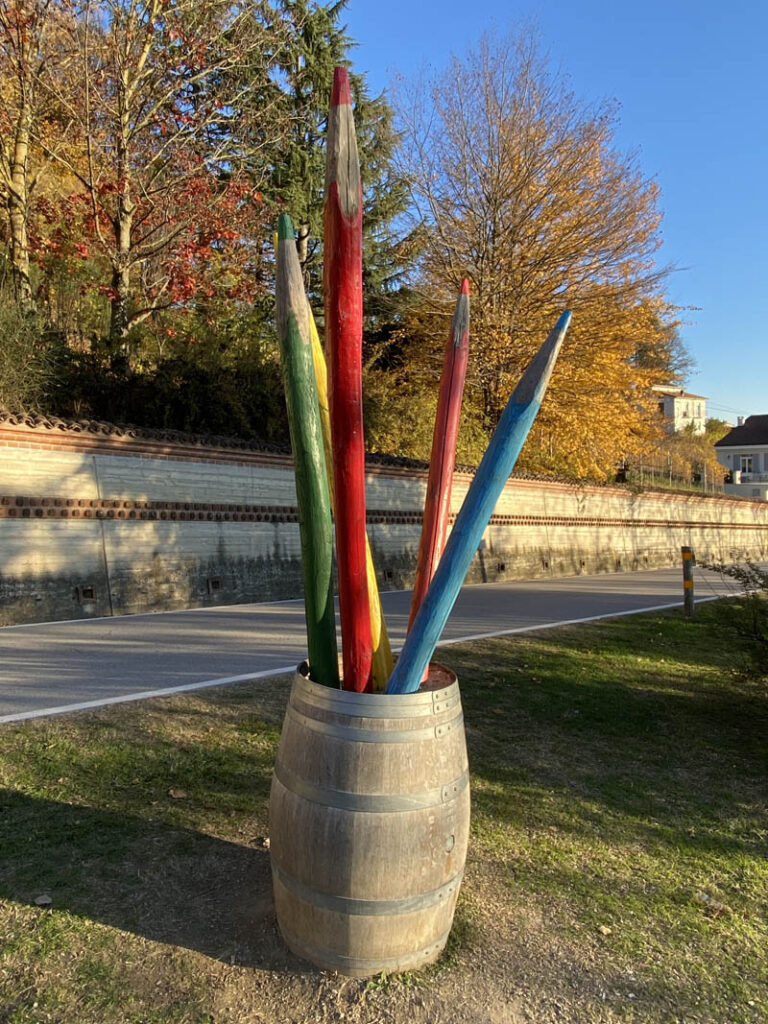
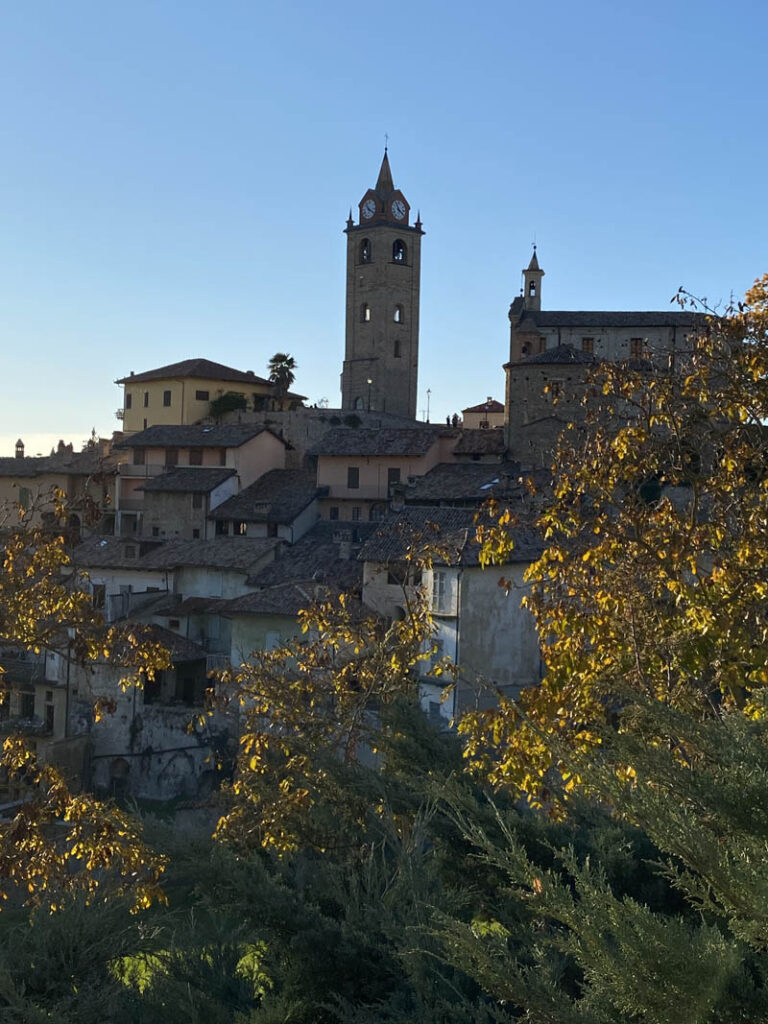
Notes: pleasant, and relaxing trekking route connecting two prestigious medieval villages with much history
behind them to tell.
Fifty percent of the route is on paved roads, but these are back roads, almost traffic-free and with fabulous
views of the Langa.
The remaining 50 percent is on farm roads, passing through vineyards, climbing hills, lapping the rows of vines,
where the eye is amply gratified among villages scattered a bit everywhere, cultivations, hills that disperse.

